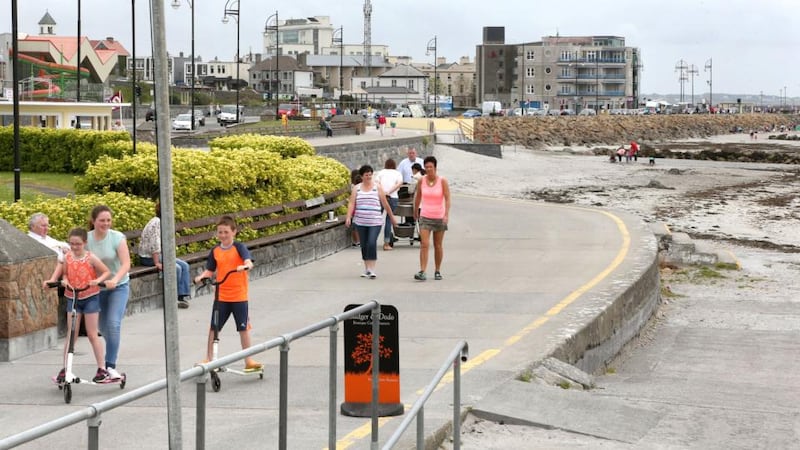The promenade at Salthill in Galway is never called that. It’s always the prom. You can walk in jig time from the centre of Galway out to Salthill. Galwegians love the Salthill prom, as do visitors.
However, dare I say it, some parts of Salthill prom are lovelier than others. I say this as someone whose mother (from Co Galway) regularly picnicked there by day, and danced by night in the ballrooms that used to line the seafront. She has been living in Co Clare far longer than she ever lived in Galway, but she continues to loyally support Galway GAA.


As I walk from the centre of Galway out to Salthill in search of the scene of the John Hinde postcard, it is only when I reach the Salthill Hotel and turn back again that I realise I have been walking in the wrong direction. The picture has been taken on the side of Salthill looking back towards Galway, not away from it. The scene in my hand and the scene I am looking at suddenly click together like two pieces in a puzzle. I am flabbergasted. It had seemed that everything I have passed on my walk along the prom had been newly built, or on a different scale from what I guessed was Salthill perhaps a half century or more ago.
I hadn’t thought I would find much, if anything, remaining of the postcard scene, because so much had changed. And yet here, right in front of me, is pretty much the same scene as in the vintage postcard. It is like a little piece of retro magic.
I stand there, lining up the view of the church tower, and the distinctive pitched-gable house book-marking a line of flat-roofed houses that march downhill to the prom on Dalysfort Road. In the foreground is a pretty park. The lovely Victorian style bandstand is still there, painted jaunty blue, yellow and red, like a little circus top. The corner building with its lovely curved balconies is still there, although the ground floor has been extended.
The Salthill of my mother’s girlhood is appearing before me. What I am looking at is probably the only remaining part of what Salthill prom looked like in the 1950s. I call her immediately to tell her. It feels like I am time-travelling.
I pass by Salthill Gardens, which is what the park is called, and walk up Dalysfort Road, which runs in front of the line of houses. The building midway down the row, gable-on to the road, is still a Garda station, as it was when the photograph was taken.
Direct provision centre
In the postcard is a yellow building behind the Garda station: the Eglinton Hotel. It is now a direct provision centre for asylum seekers, a change of use that must have seemed unimaginable in the era when the photograph was taken, in which every person in it is white.
The house at the top of the row with the unusual roof looks as if it has been unoccupied for some time. I walk along the line of flat-roofed houses and find resident Paul Duffy washing his car outside one of them. The house belonged to his grandmother, he says, and he has been living there for more than 25 years.
He looks at the postcard. He thinks he knows the couple in the foreground, walking towards the photographer: the man in a cap and brown trousers and the women in a pale green skirt, carrying a bag over her arm. “I think those people could be Sean and Mary Rita O’Byrne,” he says. “They lived further out along the prom.”
Duffy says there was a water fountain, just out of shot to the left of the postcard, which is long gone. The building with the curved balconies on the corner is Western House, then and now holiday apartment lets.
His brother-in-law and a couple of pals, who are out walking, stop to say hello.
“Look at the Anglia cars, they’re ancient.”
“Look, men in suits on the beach,” another marvels.
They speculate about when the photograph was taken. They think perhaps the late 1950s or early 1960s. They pore over the faces of the sunbathers. I get the impression they wish they were in it themselves.
It is early evening when I walk back down to the prom, but the place is still crowded. In fact it is even more crowded, as people who have finished work arrive . I sit for a while on a bench, as people in the postcard had done, surveying the glorious sunny evening and the light jumping off the restless waves.
You can’t really see the view outwards in the postcard; what people are looking at. There is just a glimpse of sea in the top-right-hand corner. But the view is the unchanging stone hills of the Burren, on the other side of Galway Bay. Buggies have replaced prams, but local families and tourists still throng Salthill prom.









